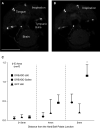Designer Receptors Exclusively Activated by Designer Drugs Approach to Treatment of Sleep-disordered Breathing
- PMID: 32673075
- PMCID: PMC7781140
- DOI: 10.1164/rccm.202002-0321OC
Designer Receptors Exclusively Activated by Designer Drugs Approach to Treatment of Sleep-disordered Breathing
Abstract
Rationale: Obstructive sleep apnea is recurrent upper airway obstruction caused by a loss of upper airway muscle tone during sleep. The main goal of our study was to determine if designer receptors exclusively activated by designer drugs (DREADD) could be used to activate the genioglossus muscle as a potential novel treatment strategy for sleep apnea. We have previously shown that the prototypical DREADD ligand clozapine-N-oxide increased pharyngeal diameter in mice expressing DREADD in the hypoglossal nucleus. However, the need for direct brainstem viral injections and clozapine-N-oxide toxicity diminished translational potential of this approach, and breathing during sleep was not examined.Objectives: Here, we took advantage of our model of sleep-disordered breathing in diet-induced obese mice, retrograde properties of the adeno-associated virus serotype 9 (AAV9) viral vector, and the novel DREADD ligand J60.Methods: We administered AAV9-hSyn-hM3(Gq)-mCherry or control AAV9 into the genioglossus muscle of diet-induced obese mice and examined the effect of J60 on genioglossus activity, pharyngeal patency, and breathing during sleep.Measurements and Main Results: Compared with control, J60 increased genioglossus tonic activity by greater than sixfold and tongue uptake of 2-deoxy-2-[18F]fluoro-d-glucose by 1.5-fold. J60 increased pharyngeal patency and relieved upper airway obstruction during non-REM sleep.Conclusions: We conclude that following intralingual administration of AAV9-DREADD, J60 can activate the genioglossus muscle and improve pharyngeal patency and breathing during sleep.
Keywords: chemogenetics; hypoglossal motoneurons; obstructive sleep apnea; pharmacotherapy.
Figures





Comment in
-
An X on the Map for Sleep Apnea's Holy Grail: Drug Therapy.Am J Respir Crit Care Med. 2021 Jan 1;203(1):10-11. doi: 10.1164/rccm.202007-2785ED. Am J Respir Crit Care Med. 2021. PMID: 32750248 Free PMC article. No abstract available.
Similar articles
-
Chemogenetic activation of hypoglossal motoneurons in a mouse model of Pompe disease.J Neurophysiol. 2022 Nov 1;128(5):1133-1142. doi: 10.1152/jn.00026.2022. Epub 2022 Aug 17. J Neurophysiol. 2022. PMID: 35976060 Free PMC article.
-
Chemogenetic stimulation of the hypoglossal neurons improves upper airway patency.Sci Rep. 2017 Mar 10;7:44392. doi: 10.1038/srep44392. Sci Rep. 2017. PMID: 28281681 Free PMC article.
-
Silencing of Hypoglossal Motoneurons Leads to Sleep Disordered Breathing in Lean Mice.Front Neurol. 2018 Nov 14;9:962. doi: 10.3389/fneur.2018.00962. eCollection 2018. Front Neurol. 2018. PMID: 30487776 Free PMC article.
-
Respiratory motor activity: influence of neuromodulators and implications for sleep disordered breathing.Can J Physiol Pharmacol. 2007 Jan;85(1):155-65. doi: 10.1139/y06-089. Can J Physiol Pharmacol. 2007. PMID: 17487255 Review.
-
Electrical stimulation of the hypoglossal nerve: a potential therapy.J Appl Physiol (1985). 2014 Feb 1;116(3):337-44. doi: 10.1152/japplphysiol.00423.2013. Epub 2013 Jun 27. J Appl Physiol (1985). 2014. PMID: 23813525 Free PMC article. Review.
Cited by
-
Leptin signaling in the dorsomedial hypothalamus couples breathing and metabolism in obesity.Cell Rep. 2023 Dec 26;42(12):113512. doi: 10.1016/j.celrep.2023.113512. Epub 2023 Nov 30. Cell Rep. 2023. PMID: 38039129 Free PMC article.
-
The Effect of DREADD Activation of Leptin Receptor Positive Neurons in the Nucleus of the Solitary Tract on Sleep Disordered Breathing.Int J Mol Sci. 2021 Jun 23;22(13):6742. doi: 10.3390/ijms22136742. Int J Mol Sci. 2021. PMID: 34201760 Free PMC article.
-
Leptin-mediated neural targets in obesity hypoventilation syndrome.Sleep. 2022 Sep 8;45(9):zsac153. doi: 10.1093/sleep/zsac153. Sleep. 2022. PMID: 35778900 Free PMC article. Review.
-
Gene delivery to the hypoglossal motor system: preclinical studies and translational potential.Gene Ther. 2021 Aug;28(7-8):402-412. doi: 10.1038/s41434-021-00225-1. Epub 2021 Feb 11. Gene Ther. 2021. PMID: 33574581 Free PMC article. Review.
-
Optogenetic activation of the tongue in spontaneously breathing mice.Respir Physiol Neurobiol. 2023 Mar;309:103998. doi: 10.1016/j.resp.2022.103998. Epub 2022 Nov 22. Respir Physiol Neurobiol. 2023. PMID: 36423822 Free PMC article.
References
-
- Gastaut H, Tassinari CA, Duron B. Polygraphic study of diurnal and nocturnal (hypnic and respiratory) episodal manifestations of Pickwick syndrome [in French] Rev Neurol (Paris) 1965;112:568–579. - PubMed
-
- Tufik S, Santos-Silva R, Taddei JA, Bittencourt LR. Obstructive sleep apnea syndrome in the Sao Paulo epidemiologic sleep study. Sleep Med. 2010;11:441–446. - PubMed
-
- Punjabi NM, Bandeen-Roche K, Marx JJ, Neubauer DN, Smith PL, Schwartz AR. The association between daytime sleepiness and sleep-disordered breathing in NREM and REM sleep. Sleep. 2002;25:307–314. - PubMed
Publication types
MeSH terms
Substances
Grants and funding
LinkOut - more resources
Full Text Sources
Other Literature Sources

